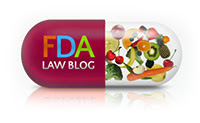
Posted: 01 May 2019 01:37 AM PDT
Last week FDA issued a final guidance, Unique Device Identification: Convenience Kits, which clarifies FDA’s interpretation of a convenience kit for purposes of UDI labeling requirements. We previously blogged on the draft version here. As our readers know, the unique device identification system regulations require that the label and device package of a device must bear a UDI, unless an exception or alternative applies. One such exception is for devices packaged within the immediate container of a convenience kit if the label of the convenience kit bears a UDI. 21 C.F.R. § 801.30(a)(11).
Unchanged from the draft guidance is FDA’s definition of a convenience kit: A convenience kit is “two or more different medical devices packaged together for the convenience of the user” (21 CFR 801.3). FDA interprets this to mean a device that contains two or more different medical devices packaged together and intended to remain packaged together and not to be replaced, substituted, repackaged, sterilized, or otherwise processed or modified before being used by an end user. FDA clarifies that “packaged together” means packed (e.g., wrapped or sealed) in a single container that is not intended to be unwrapped or unsealed before it is used by an end user. Notably, the guidance does not apply to kits that contain deices co-packaged with drugs.
Kits that meet the definition of a “convenience kit” must include a UDI on the kit label and the individual devices within the kit are exempt from the requirement to bear a UDI. 21 C.F.R. § 801.30(a)(11). Medical devices that are a part of kits that do not meet this definition must be individually labeled in accordance with applicable UDI requirements.
The final guidance includes additional examples and clarifications:
A few key points regarding this final guidance:
These additional examples help to clarify some of the takeaways we previously reported. For example, the draft guidance implied that if any devices in a kit required sterilization prior to use, it could not be considered a convenience kit. Based on the fourth example in the final guidance, however, there is a noteworthy exemption from this general rule. If the product is initially provided as sterile, but requires sterilization after its first use, FDA would consider this a convenience kit.
We also note, as we did in our previous post, that the intent of the labeler informs the determination of whether a kit is a convenience kit for UDI purposes. How the product is used has no bearing on the analysis.
Unchanged from the draft guidance is FDA’s definition of a convenience kit: A convenience kit is “two or more different medical devices packaged together for the convenience of the user” (21 CFR 801.3). FDA interprets this to mean a device that contains two or more different medical devices packaged together and intended to remain packaged together and not to be replaced, substituted, repackaged, sterilized, or otherwise processed or modified before being used by an end user. FDA clarifies that “packaged together” means packed (e.g., wrapped or sealed) in a single container that is not intended to be unwrapped or unsealed before it is used by an end user. Notably, the guidance does not apply to kits that contain deices co-packaged with drugs.
Kits that meet the definition of a “convenience kit” must include a UDI on the kit label and the individual devices within the kit are exempt from the requirement to bear a UDI. 21 C.F.R. § 801.30(a)(11). Medical devices that are a part of kits that do not meet this definition must be individually labeled in accordance with applicable UDI requirements.
The final guidance includes additional examples and clarifications:
- First aid kits
- Non-sterile orthopedic device set
- Single use disposable medical procedure kit
- Sterile kit containing both single-use and reusable medical devices packaged together
- Different devices packaged together for the convenience of the user but the collection of devices is not itself a device
A few key points regarding this final guidance:
These additional examples help to clarify some of the takeaways we previously reported. For example, the draft guidance implied that if any devices in a kit required sterilization prior to use, it could not be considered a convenience kit. Based on the fourth example in the final guidance, however, there is a noteworthy exemption from this general rule. If the product is initially provided as sterile, but requires sterilization after its first use, FDA would consider this a convenience kit.
We also note, as we did in our previous post, that the intent of the labeler informs the determination of whether a kit is a convenience kit for UDI purposes. How the product is used has no bearing on the analysis.





















.png)









No hay comentarios:
Publicar un comentario